New Submicron Low Gate Leakage In0.52Al0.48As-In0.7Ga0.3As pHEMT for Low-Noise Applications
Abstract
:1. Introduction
2. Samples: Device Material Epitaxial Growth
Hall Effect Measurements and Band Diagrams
3. Device Fabrication
4. Results and Discussion
4.1. Direct Current (DC) Characteristics
4.2. Radio Frequency (RF) Characteristics
5. Conclusions
Author Contributions
Funding
Acknowledgments
Conflicts of Interest
References
- Smith, P.M.; Nichols, K.; Kong, W.; MtPleasant, L.; Pritchards, D.; Lender, R.; Fisher, J.; Actis, R.; Dugas, D.; Meharry, D.; et al. Advances in InP HEMT Technology for High Frequency Applications. In Proceedings of the 2001 International Conference on Indium Phosphide and Related Materials, 13th IPRM (Cat. No. 01CH37198), Nara, Japan, 14–18 May 2001; pp. 9–14. [Google Scholar]
- Nguyen, L.D.; Larson, L.E.; Mishra, U.K. Ultra-High-Speed Modulation-Doped Field-Effect Transistors: A Tutorial Review. Proc. IEEE 1992, 80, 494–518. [Google Scholar] [CrossRef]
- Ajayan, J.; Nirmal, D. A review of InP/InAlAs/InGaAs based transistors for high frequency applications. Superlattices Microstruct. 2015, 86, 1–19. [Google Scholar] [CrossRef]
- People, R.; Wecht, K.W.; Alavi, K.; Cho, A.Y. Measurement of the conduction-band discontinuity of molecular beam epitaxial grown In0.52Al0.48As/In0.53Ga0.47As, N-n heterojunction by C-V profiling. Appl. Phys. Lett. 1983, 43, 118–120. [Google Scholar] [CrossRef]
- Ying-Hui, Z.; Xian-Tai, W.; Yong-Bo, S.; Yu-Xiong, C.; Yu-Ming, Z.; Xin-Yu, L.; Zhi, J. High performance InP-based In0.52Al0.48As/In0.53Ga0.47As HEMTs with extrinsic transconductance of 1052 mS/mm. J. Infrared Millim. Waves 2013, 32, 193. [Google Scholar]
- Bouloukou, A.; Boudjelida, B.; Sobih, A.; Boulay, S.; Sly, J.; Missous, M. Design of low leakage InGaAs/InAlAs pHEMTs for wide band (300 MHz to 2 GHz) LNAs. In Proceedings of the 2008 International Conference on Advanced Semiconductor Devices and Microsystems, Smolenice, Slovakia, 12–16 October 2008; pp. 79–82. [Google Scholar]
- Bouloukou, A.; Boudjelida, B.; Sobih, A.; Boulay, S.; Sly, J.; Missous, M. Very low leakage InGaAs/InAlAs pHEMTs for broadband (300 MHz to 2 GHz) low-noise applications. Mater. Sci. Semicond. Process. 2008, 11, 390–393. [Google Scholar] [CrossRef]
- Sadwick, L.P.; Kim, C.W.; Tan, K.L.; Streit, D.C. Schottky barrier heights of n-type and p-type al/sub 0.48/In/sub 0.52/As. IEEE Electron Device Lett. 1991, 12, 626–628. [Google Scholar] [CrossRef]
- Auer, U.; Reuter, R.; Ellrodt, P.; Heedt, C.; Prost, W.; Tegude, F.J. The impact of pseudomorphic AlAs spacer layers on the gate leakage current of InAlAs/InGaAs heterostructure field-effect transistors. In Proceedings of the Seventh International Conference on Indium Phosphide and Related Materials, Sapporo, Japan, 9–13 May 1995; pp. 424–427. [Google Scholar]
- Prost, W.; Reuter, R.; Liu, Q.; Heedt, C.; Tegude, F.J.; Lindner, A.; Scheffer, F. High breakdown voltage InGaAs/InAlAs HFET using In0.56Ga0.5P spacer layer. Electron. Lett. 1994, 30, 169–170. [Google Scholar]
- Cavassilas, N.; Aniel, F.; Boucaud, P.; Adde, R.; Maher, H.; Décobert, J.; Scavennec, A. Electroluminescence of composite channel InAlAs/InGaAs/InP/InAlAs high electron mobility transistor. J. Appl. Phys. 2000, 87, 2548–2552. [Google Scholar] [CrossRef] [Green Version]
- Hur, K.Y.; McTaggart, R.A.; Lemonias, P.J.; Hoke, W.E. Development Of Double Recessed AlInAs/GaInAs/InP HEMTs For Millimeter Wave Power Applications. Solid-State Electron. 1997, 41, 1581–1585. [Google Scholar] [CrossRef]
- Bhat, K.M.; Pathak, S.; Saravanan, G.S.; Sridhar, C.; Bhaskar, S.; Badnikar, S.L.; Vyas, H.P.; Muralidharan, R.; Jain, M.K.; Subrahmanyam, A. Fabrication of double recess structure by single lithography step using silicon-nitride-assisted process in pseudomorphic HEMTs. Microelectron. Eng. 2014, 127, 61–67. [Google Scholar] [CrossRef]
- Bouloukou, A.; Sobih, A.; Kettle, D.; Sly, J.; Missous, M. Novel high breakdown InGaAs/InAlAs pHEMTs for radio astronomy applications. In Proceedings of the 4th ESA Workshop on Millimeter Wave Technology and Applications (7th MINT Millimiter-Wave International Symposium), Espoo, Finland, 15–17 February 2006. [Google Scholar]
- Lide, D.R. (Ed.) Properties of Solids. In Handbook of Chemistry and Physics, 90th ed.; (CD-ROM Version 2010); CRC Press/Taylor and Francis: Boca Raton, FL, USA, 2010; p. 2661. [Google Scholar]
- Chang, C.Y.; Hsu, H.T.; Chang, E.Y.; Kuo, C.I.; Datta, S.; Radosavljevic, M.; Miyamoto, Y.; Huang, G.W. Investigation of Impact Ionization in InAs-Channel HEMT for High-Speed and Low-Power Applications. IEEE Electron Device Lett. 2007, 28, 856–858. [Google Scholar] [CrossRef]
- Palmateer, L.F.; Tasker, P.J.; Schaff, W.J.; Nguyen, L.D.; Eastman, L.F. dc and rf measurements of the kink effect in 0.2 μm gate length AlInAs/GaInAs/InP modulation-doped field-effect transistors. Appl. Phys. Lett. 1989, 54, 2139–2141. [Google Scholar] [CrossRef]
- Chavarkar, P.; Mishra, U. Field Effect Transistors: FETs AND HEMTs. Thin Films 2001, 28, 71–145. [Google Scholar]
- Li, S.S. Semiconductor Physical Electronics; Springer: Gainesville, FL, USA, 2006; p. 632. [Google Scholar]
- Thobel, J.L.; Baudry, L.; Cappy, A.; Bourel, P.; Fauquembergue, R. Electron transport properties of strained InxGa1-xAs. Appl. Phys. Lett. 1990, 56, 346–348. [Google Scholar] [CrossRef]
- Nguyen, L.D.; Brown, A.S.; Thompson, M.A.; Jelloian, L.M. 50-nm Self-Aligned-Gate Pseudomorphic AlInAs/GaInAs High Electron Mobility Transistors. IEEE Trans. Electron Devices 2007, 39, 2007–2014. [Google Scholar] [CrossRef]
- Munns, G.O.; Sherwin, M.E.; Brock, T.; Haddad, G.I.; Kwon, Y.; Ng, G.I.; Pavlidis, D. InAlAs/InGaAs/InP sub-micron HEMTs grown by CBE. J. Cryst. Growth 1992, 120, 184–188. [Google Scholar] [CrossRef] [Green Version]
- Iwata, N.; Tomita, M.; Kuzuhara, M. High Performance Double-Doped InAlAs/InGaAs/InP Heterojunction FET With Potential For Millimetre-Wave Power Applications. Electron. Lett. 1993, 29, 628–629. [Google Scholar] [CrossRef]
- Kohen, D.; Nguyen, X.S.; Made, R.I.; Heidelberger, C.; Lee, K.H.; Lee, K.E.K.; Fitzgerald, E.A. Preventing phase separation in MOCVD-grown InAlAs compositionally graded buffer on silicon substrate using InGaAs interlayers. J. Cryst. Growth 2017, 478, 64–70. [Google Scholar] [CrossRef]
- Li, S. (Ed.) High-Speed III-V Semiconductor Devices. In Semiconductor Physical Electronics; Springer: New York, NY, USA, 2006; pp. 613–663. [Google Scholar]
- Lee, K.S. InAlAs/InGaAs/InP HEMTs with Pseudomorphic Schottky Barriers. Ph.D. Thesis, Massachusetts Institute of Technology, Cambridge, MA, USA, 1994. [Google Scholar]
- Brown, A.S.; Chou, C.S.; Delaney, M.J.; Hooper, C.E.; Jensen, J.F.; Larson, L.E.; Mishra, U.K.; Nguyen, L.D.; Thompson, M.S. Low-Temperature Buffer AlInAs/GaInAs on InP HEMT Technology for Ultra-High-Speed Integrated Circuits. In Proceedings of the 11th Annual Gallium Arsenide Integrated Circuit (GaAs IC) Symposium, San Diego, CA, USA, 22–25 October 1989; pp. 143–146. [Google Scholar]
- Auer, U.; Reuter, R.; Heedt, C.; Kunzel, H.; Prost, W.; Tegude, F.J. InAlAs/InGaAs HFET with extremely High Device Breakdown Using an Optimized Buffer Layer Structure. In Proceedings of the1994 IEEE 6th International Conference on Indium Phosphide and Related Materials (IPRM), Santa Barbara, CA, USA, 27–31 March 1994; pp. 443–446. [Google Scholar]
- Prost, W.; Tegude, F.J. High speed, high gain InP-based heterostructure FETs with high breakdown voltage and low leakage. In Proceedings of the Seventh International Conference on Indium Phosphide and Related Materials, Hokkaido, Japan, 9–13 May 1995; pp. 729–732. [Google Scholar]
- Grunenputt, J.E. Pseudomorphic and Metamorphic HEMT-Technologies for Industrial W-Band Low-Noise and Power Applications. Ph.D. Thesis, Universität Ulm, Ulm, Germany, 2010. [Google Scholar]
- Actis, R.; Nichols, K.B.; Kopp, W.F.; Rogers, T.J.; Smith, F.W. High-Performance 0.15-μm-Gate-Length pHEMTs Enhanced with a Low-Temperature-Grown GaAs Buffer. In Proceedings of the IEEE MTT-S International Microwave Symposium Digest, Orlando, FL, USA, 16–20 May 1995; pp. 445–448. [Google Scholar]
- Khorenko, V.; Mofor, A.C.; Bakin, A.; Neumann, S.; Guttzeit, A.; Wehmann, H.H.; Prost, W.; Schlachetzki, A.; Tegude, F.J. Buffer Optimization For InP-On-Si [001] Quasi-Substrates. In Proceedings of the 16th IPRM. 2004 International Conference on Indium Phosphide and Related Materials, Kagoshima, Japan, 31 May–4 June 2004; pp. 118–121. [Google Scholar]
- Prasad, S.; Schumacher, H.; Gopinath, A. Electronic devices. In High-Speed Electronics and Optoelectronics: Devices and Circuits; Cambridge University Press: Cambridge, MA, USA, 2009; pp. 46–162. [Google Scholar]
- Zhiming, W.; Xin, L.; Xiaobin, L.; Yuxing, C.; Xiguo, S.; Jianghui, M.; Xingchang, F.; Liang, L.; Dawei, H. Design of InAlAs/InGaAs PHEMTs and small-signal modeling from 0.5 to 110 GHz. J. Semicond. 2015, 36, 024005. [Google Scholar]
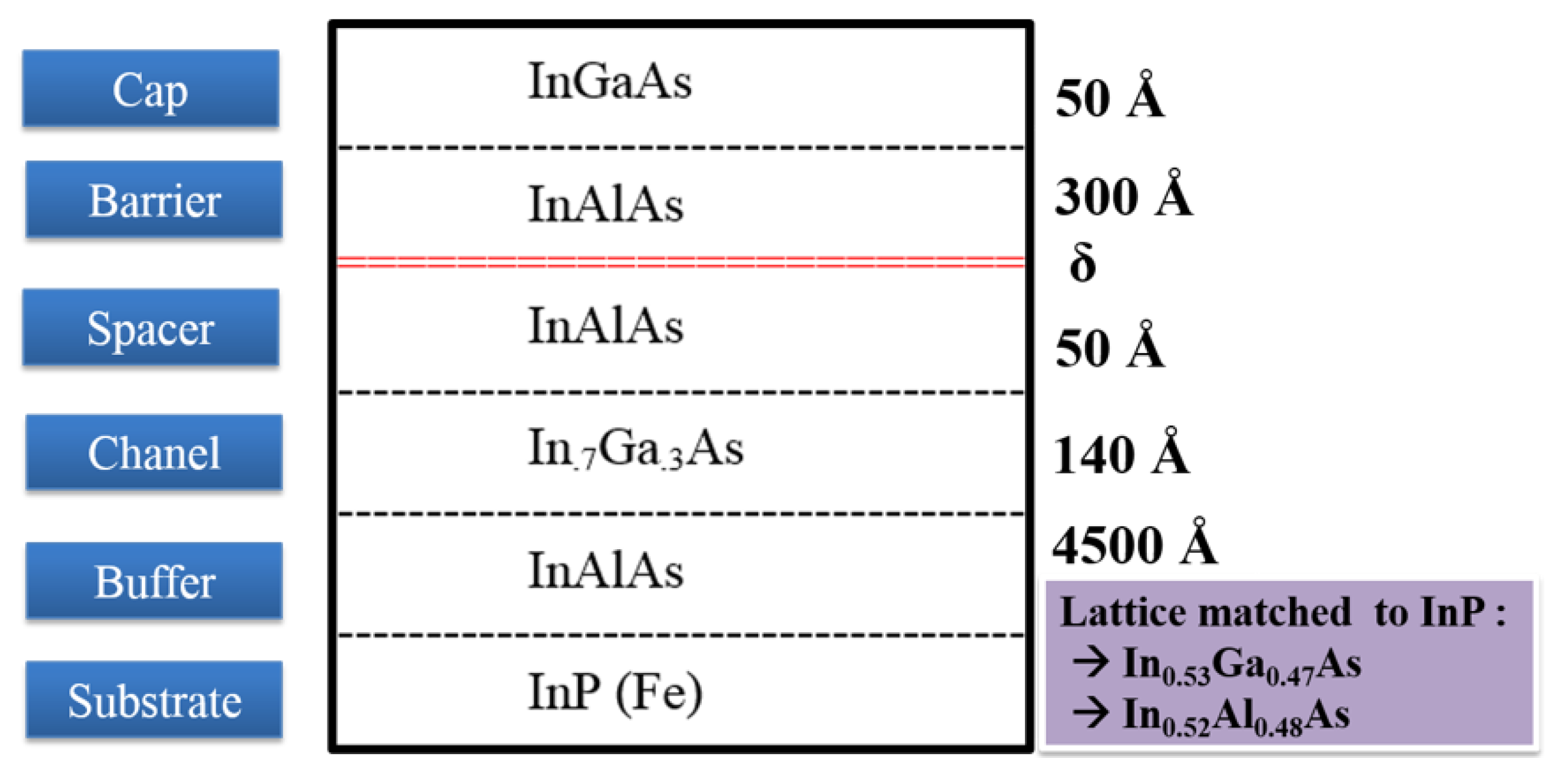
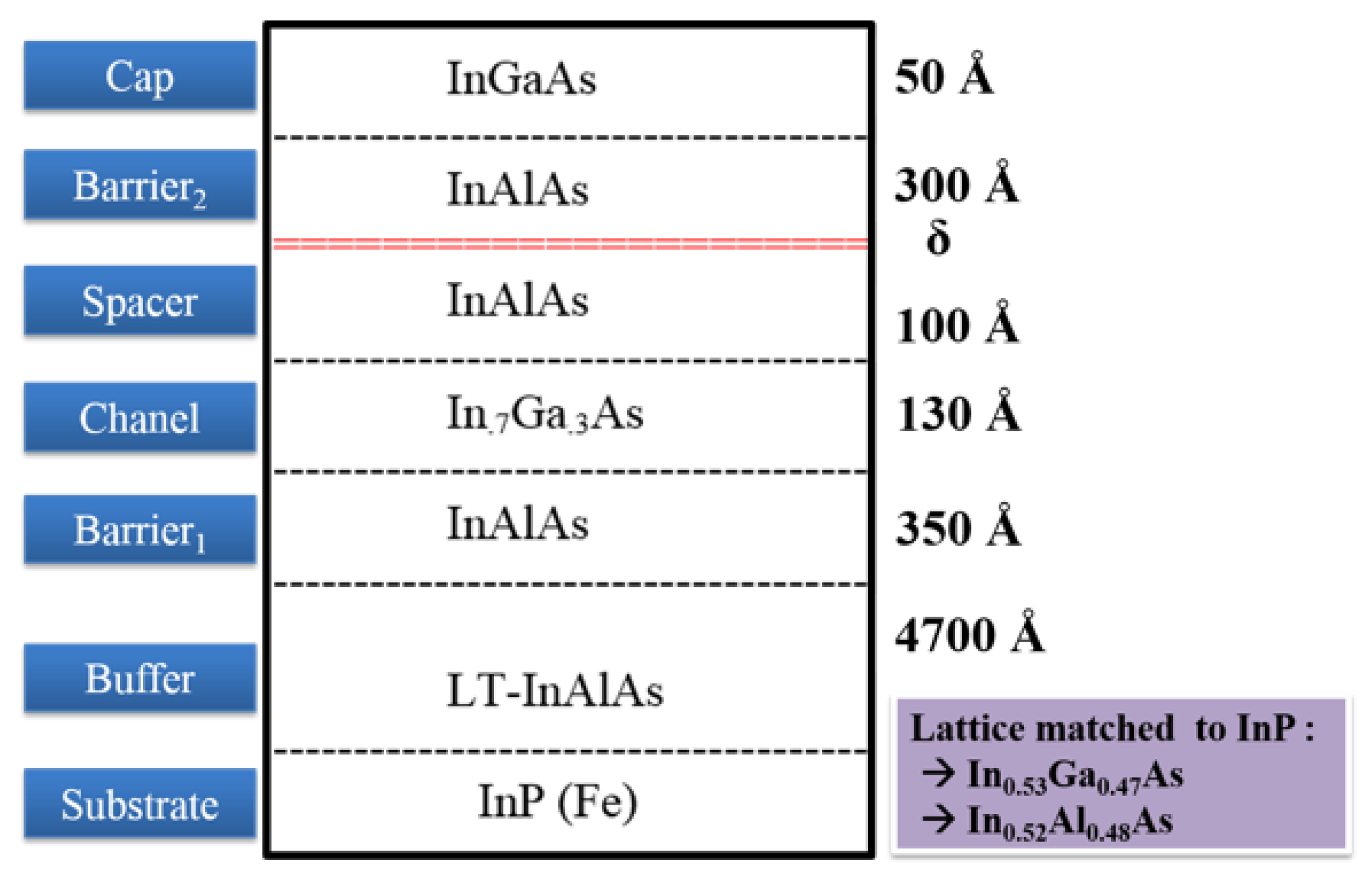

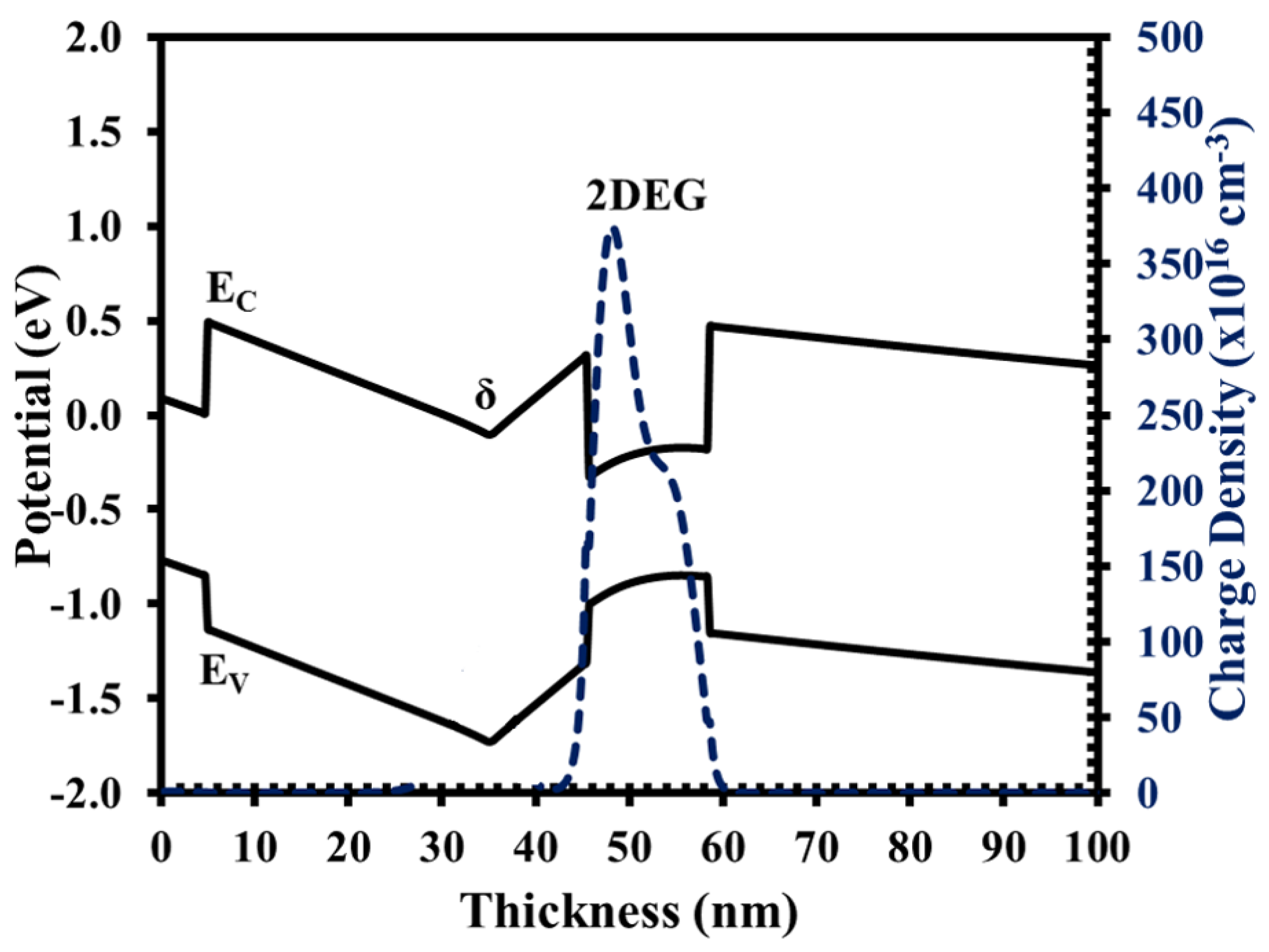
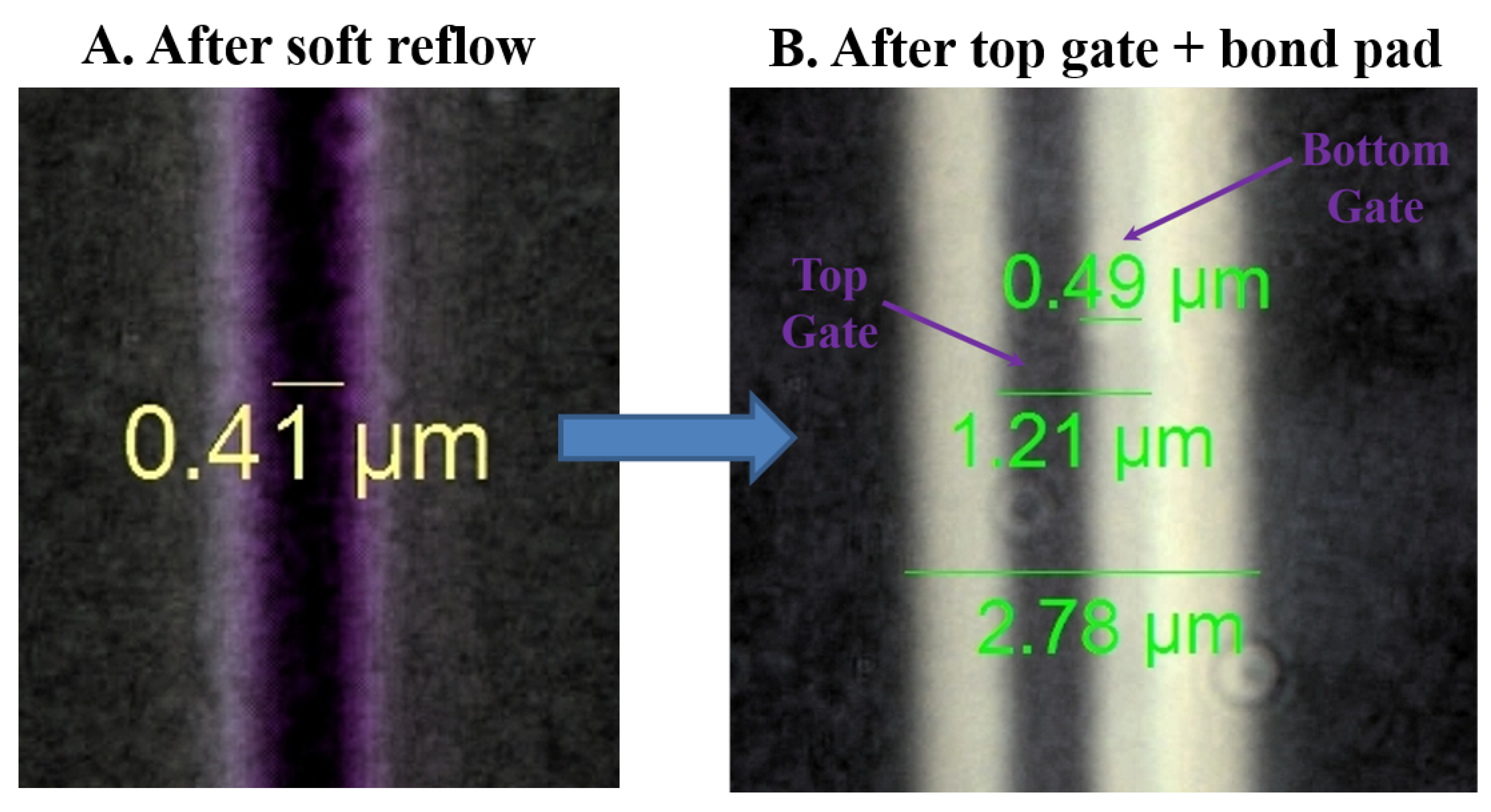
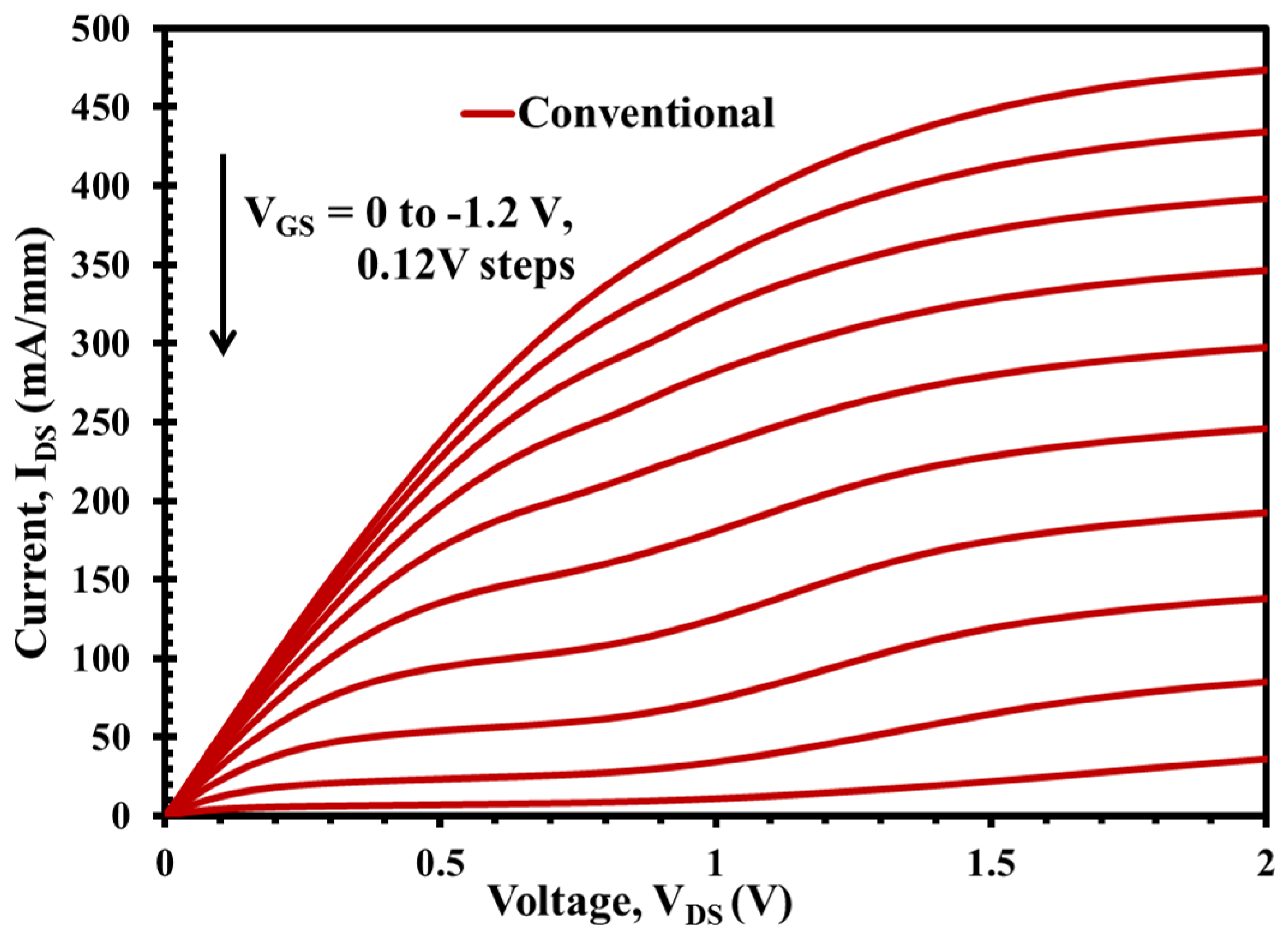
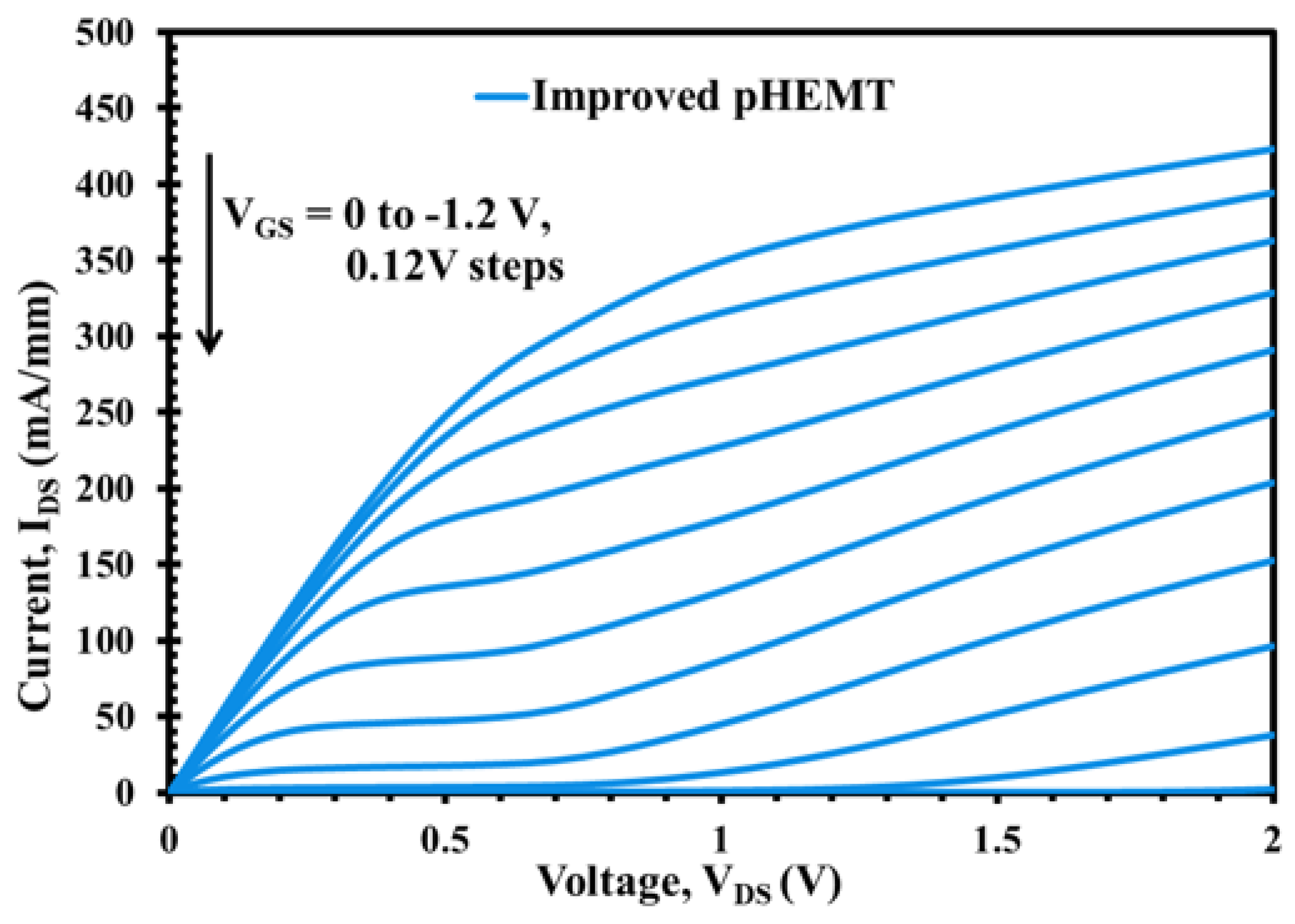
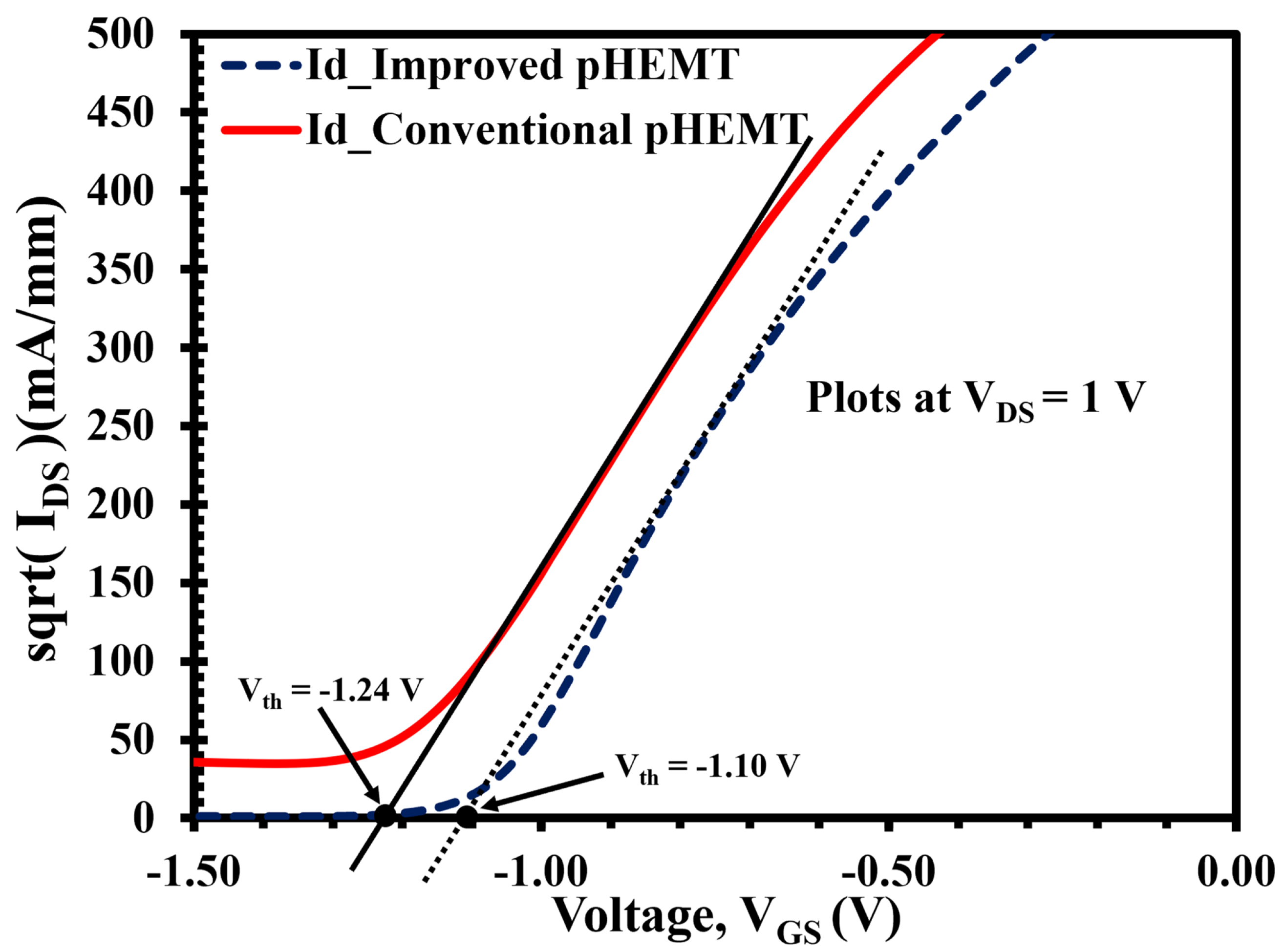
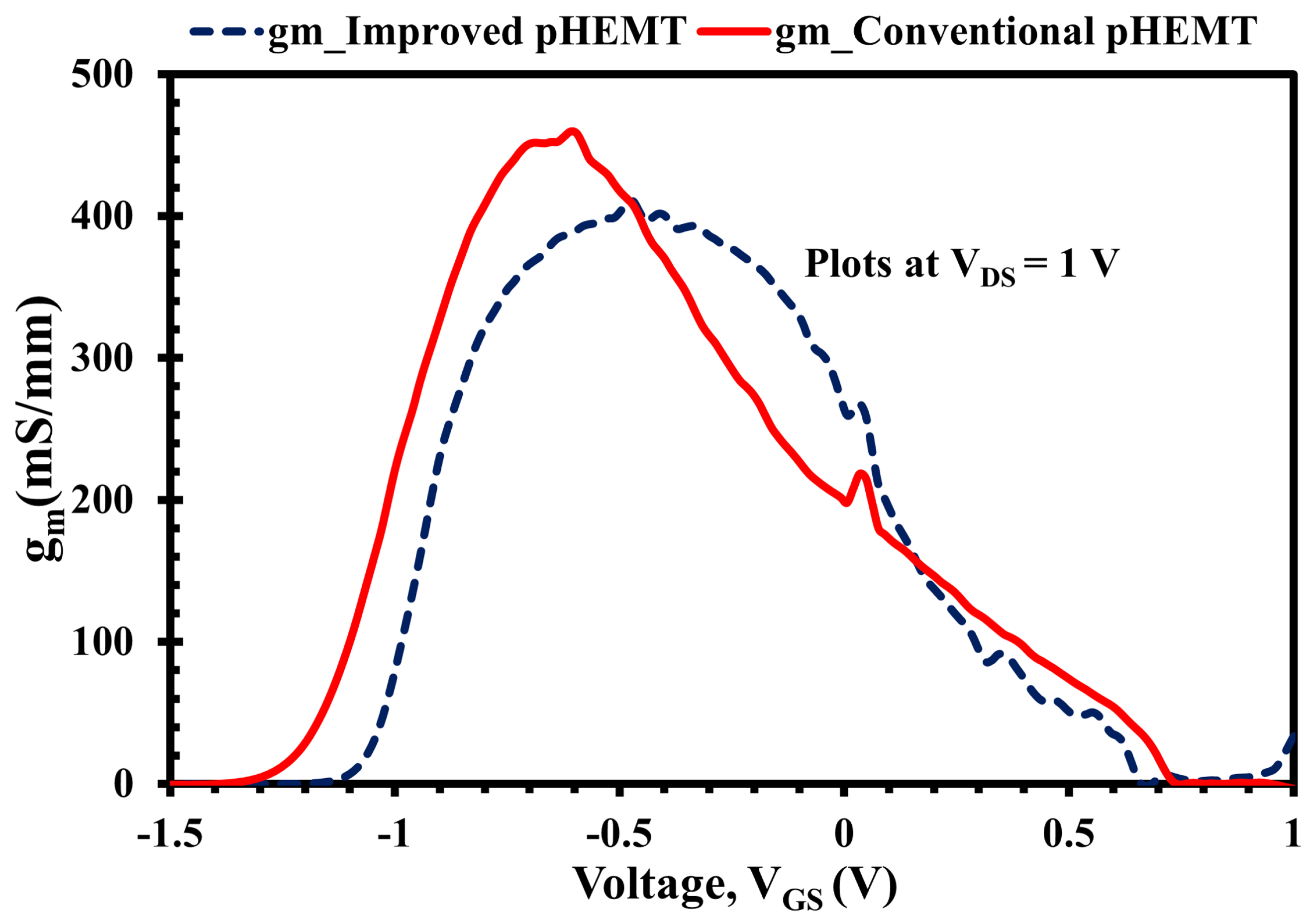
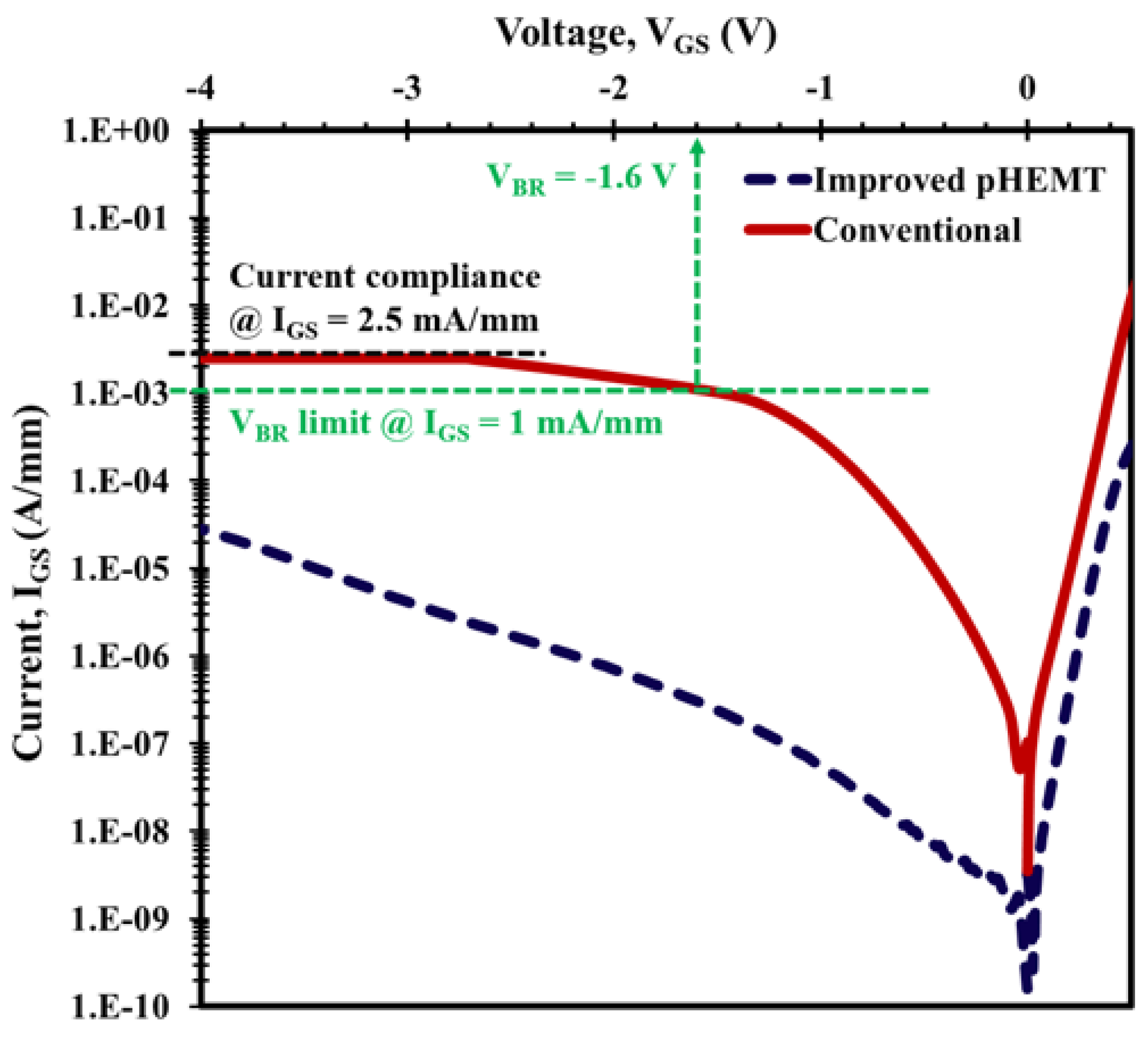
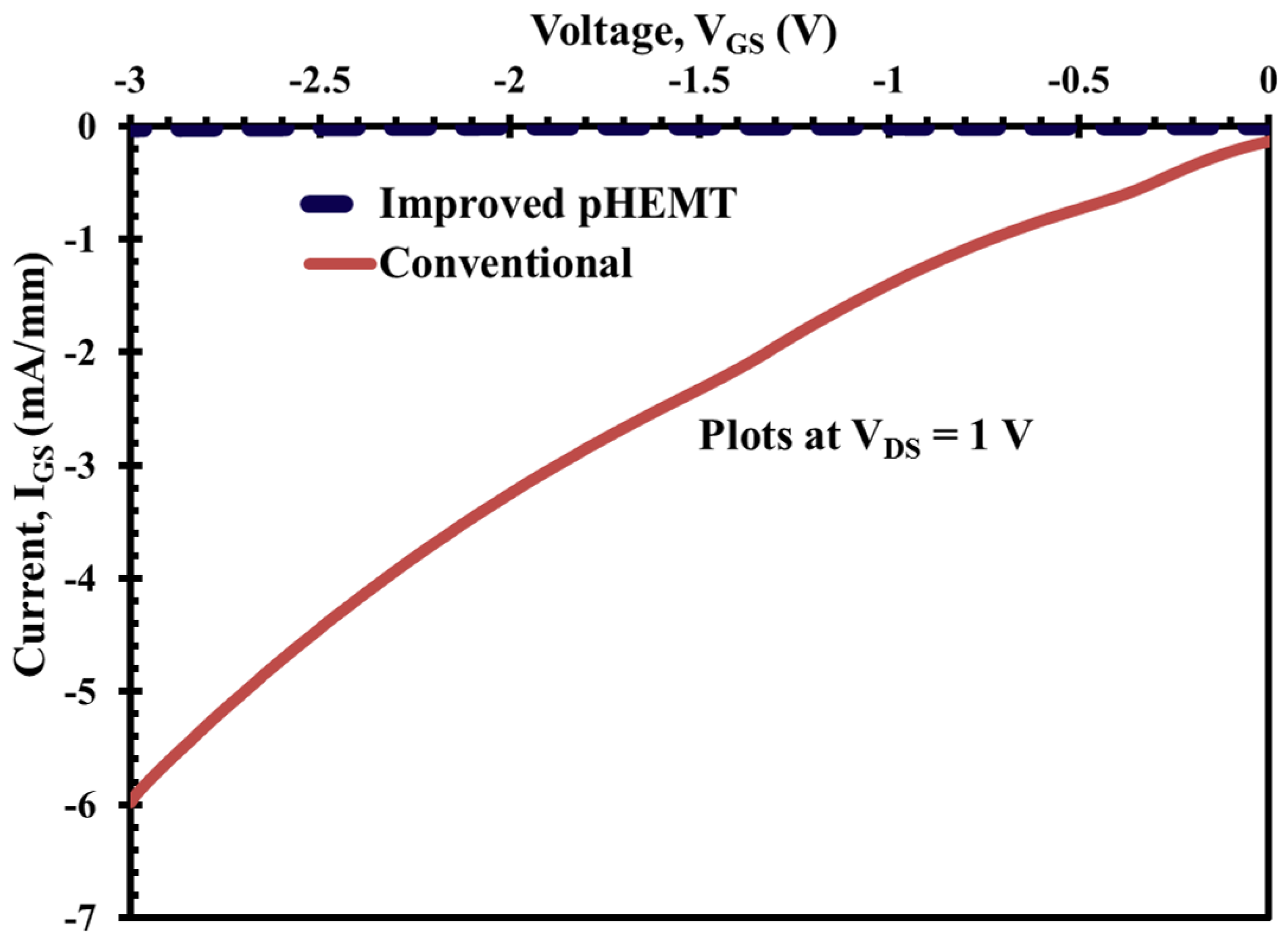

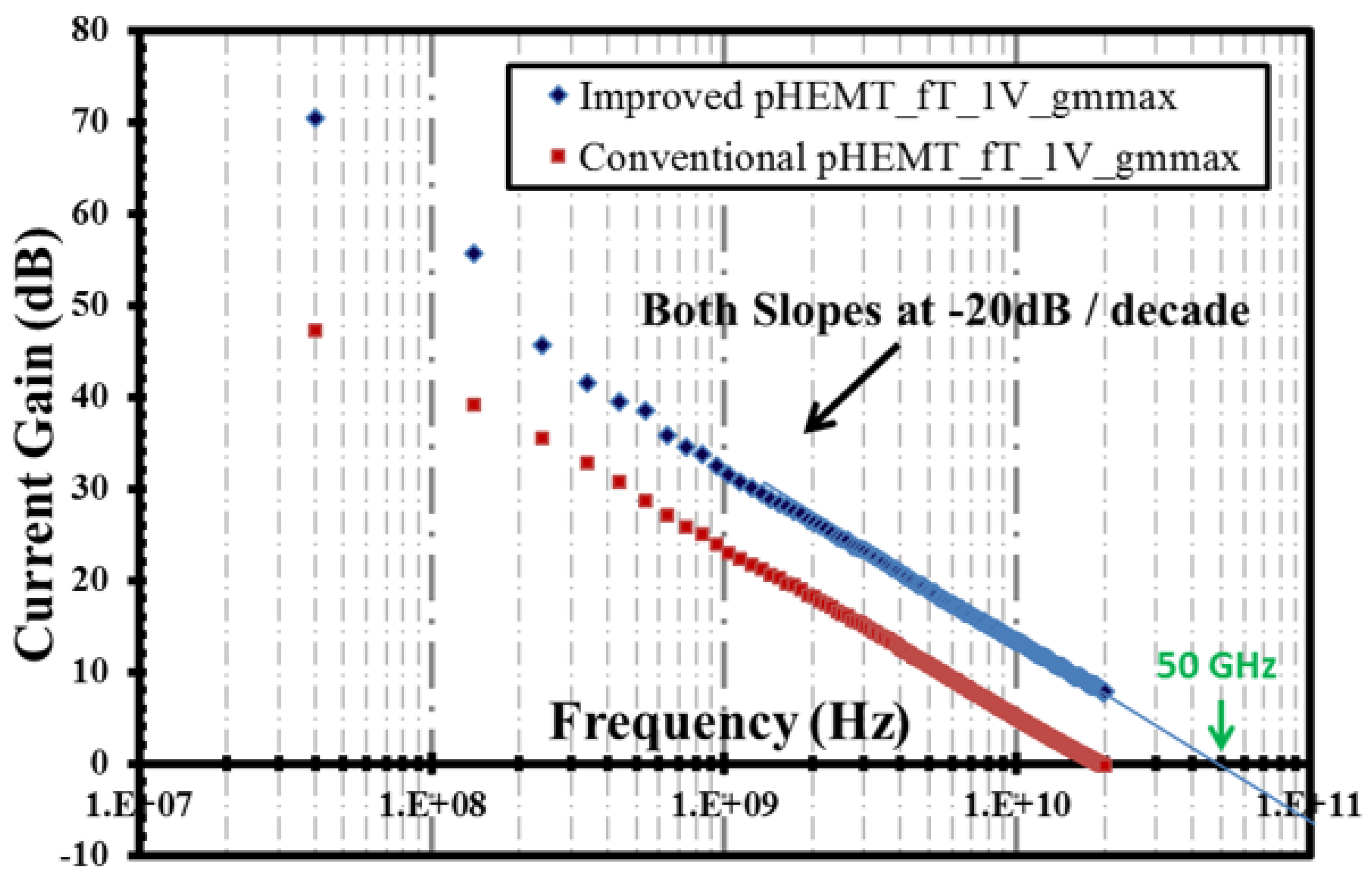
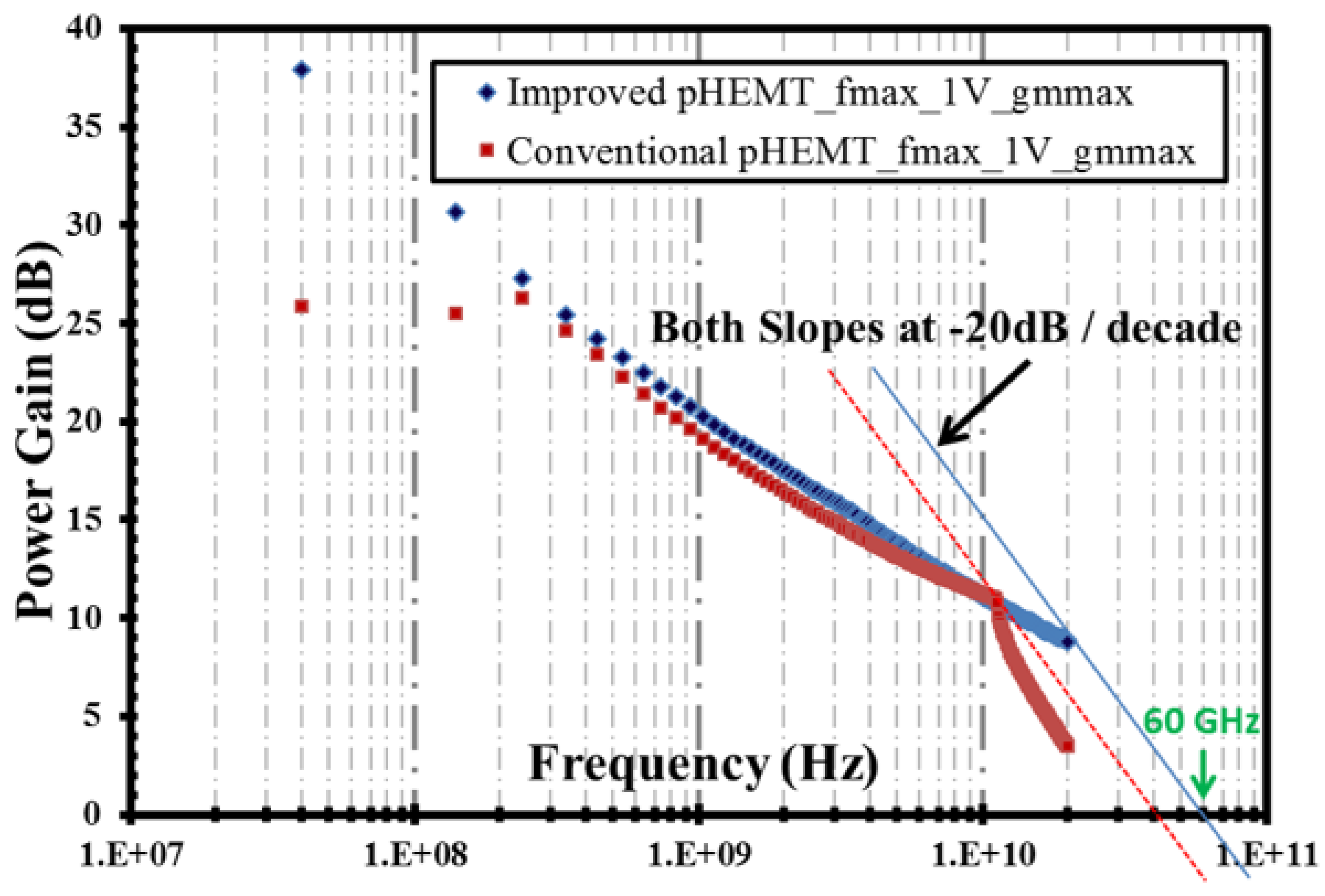
| Device | Wide Band Gap1 | Narrow Band Gap2 | Eg1 (eV) | Eg2 (eV) | Eg (eV) |
|---|---|---|---|---|---|
| XMBE171 | InAlAs | InGaAs | 1.4 | 0.579 | 0.821 |
| XMBE56 | InAlAs | InGaAs | 1.4 | 0.579 | 0.821 |
| Measurement | XMBE171 | XMBE56 |
|---|---|---|
| Sheet Carrier Concentration (n) at 300 K/77 K ( × 10 cm) | 3.16/3.56 | 2.47/2.61 |
| Hall Mobility () at 300 K/77 K (cm/V·s) | 10,653/24,649 | 13,169/42,906 |
| Parameter | XMBE171 | XMBE56 |
|---|---|---|
| R (/mm) | 182 | 155 |
| R (.mm) | 0.19 | 0.13 |
| Parameter | XMBE56 | XMBE171 |
|---|---|---|
| g (mS/mm) | 410 ± 5 | 459 ± 5 |
| V (V) | 1.0 | 1.0 |
| V (V) | −0.47 ± 5 | −0.61 ± 5 |
| I (mA/mm) | 171.5 ± 1 | 173.3 ± 1 |
Publisher’s Note: MDPI stays neutral with regard to jurisdictional claims in published maps and institutional affiliations. |
© 2021 by the authors. Licensee MDPI, Basel, Switzerland. This article is an open access article distributed under the terms and conditions of the Creative Commons Attribution (CC BY) license (https://creativecommons.org/licenses/by/4.0/).
Share and Cite
Packeer Mohamed, M.F.; Mohamed Omar, M.F.; Akbar Jalaludin Khan, M.F.; Ghazali, N.A.; Hairi, M.H.; Falina, S.; Samsol Baharin, M.S.N. New Submicron Low Gate Leakage In0.52Al0.48As-In0.7Ga0.3As pHEMT for Low-Noise Applications. Micromachines 2021, 12, 1497. https://doi.org/10.3390/mi12121497
Packeer Mohamed MF, Mohamed Omar MF, Akbar Jalaludin Khan MF, Ghazali NA, Hairi MH, Falina S, Samsol Baharin MSN. New Submicron Low Gate Leakage In0.52Al0.48As-In0.7Ga0.3As pHEMT for Low-Noise Applications. Micromachines. 2021; 12(12):1497. https://doi.org/10.3390/mi12121497
Chicago/Turabian StylePackeer Mohamed, Mohamed Fauzi, Mohamad Faiz Mohamed Omar, Muhammad Firdaus Akbar Jalaludin Khan, Nor Azlin Ghazali, Mohd Hendra Hairi, Shaili Falina, and Mohd Syamsul Nasyriq Samsol Baharin. 2021. "New Submicron Low Gate Leakage In0.52Al0.48As-In0.7Ga0.3As pHEMT for Low-Noise Applications" Micromachines 12, no. 12: 1497. https://doi.org/10.3390/mi12121497








